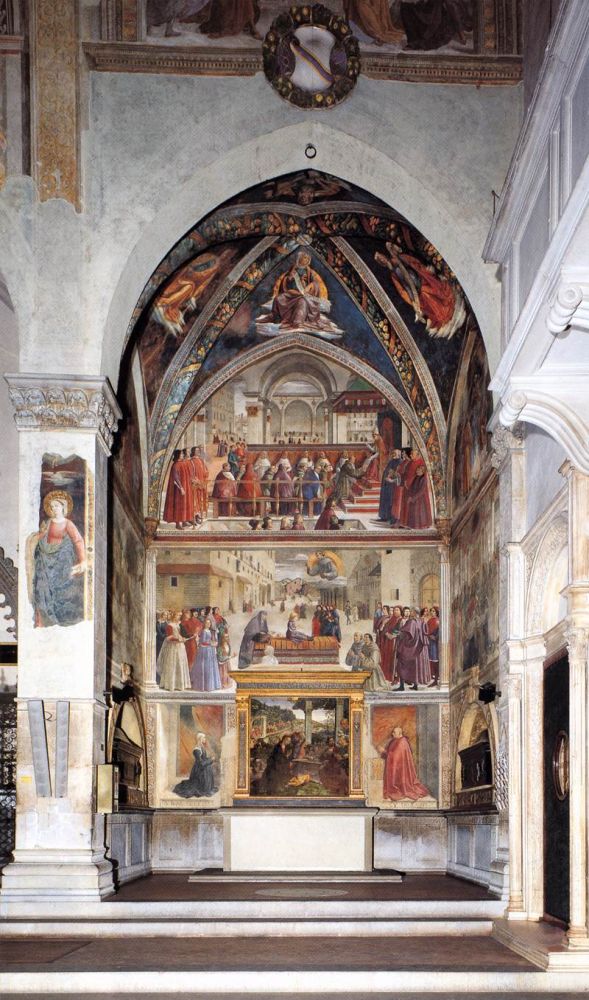

Do you remember the Patriarchs frescoed on the sails of the Strozzi Chapel vault in the Santa Maria Novella church..? Let's now skip to another vault in another chapel, boasting yet more amazing murals: the fresco cycle in the Sassetti Chapel in Santa Trinita, painted between 1482 and 1485 by Domenico Ghirlandaio (Michelangelo's teacher) and his many assistants. Francesco Sassetti was an agent of the Medici bank. The six main frescoes represent scenes from the life of St Francis of Assisi, Sassetti’s patron saint: The Renunciation of Worldly Goods; The Confirmation Of The Franciscan Rule, The Test of Fire, The Miracle Of The Stigmata, The Death Of St. Francis, The Resurrection Of The Boy.
Let's talk first about the fresco technique, which Domenico Ghirlandaio mastered -don’t forget that he taught this technique to Michelangelo Buonarroti..!
“Fresco” means “fresh” in Italian, i. e. “painted on wet plaster” with water-based pigments. When plaster dries, they become part of the matrix of the wall. Pigments become part of the matrix of the wall due to the chemical process of carbonatation. The fresco painting consists of three strata and the materials they're made of; the arriccio, a rough under layer to smooth out the wall, 3:1 sand to lime paste, which is absorbent, retains water, and dries slowly; intonaco, a smooth upper layer upon what the final painting is performed (1:1 fine sand to lime paste), drying fast; the painted surface, which in this way becomes very durable, as resistant as stone, and lasts forever with its brilliant, vibrant colours. As a matter of fact, this fresco cycle looks as if it were painted only a short time ago. Florentine painters were actually the most skilled at this technique.
The Stories of Saint Francis take place in Renaissance Florence, and contain many details of the buildings and customs of the time: see for instance The Confirmation of the Franciscan Rule, which takes place in a stern Piazza della Signoria with the Loggia dei Lanzi and the Arengario devoid of statues; at the time, the Loggia was only a venue for the the Republic’s public ceremonies, before the Medici family made it the breathtaking gallery of statues we recognize today, to display their power and prestige. There are numerous portraits of members of the Sassetti family, shown with some of the leading members of the Medici family, and of leading members of the Florentine mercantile aristocracy. Take a look in particular at Lorenzo the Magnificent, and his three sons (Giuliano Duke of Nemours, Piero the Unfortunate, Giovanni – who was to become Pope Leone X) climbing the stairs alongside the Medici court poet Agnolo Poliziano. Ghirlandaio was one of the best Renaissance painters, and one of the best of all time, most well-known for his accurate yet dignified Classical realism.
Now take a look at The Resurrection of the Boy, which takes place in the Piazza Santa Trinita. You can still admire the Santa Trinita basilica's Romanesque façade, before it was covered by Bernardo Buontalenti’s new one (although the counterfaçade remains untouched), as well as the old Santa Trinita bridge, before it was damaged by the Florentine flood in 1557.
The altarpiece, dating back to 1485, contains further evidence of Ghirlandaio’s interest in Classical antiquity, showing The Adoration of the Shepherds with a Roman triumphal arch in the background, and a Roman sarcophagus in place of the traditional manger. The “stable” (what Romans used to call the “tugurium”) is propped up by majestic, square-fluted columns, crowned by elegant Corynthian capitels. Not everybody knows that, according to a Christian tradition (Jacobus de Voragine), Jesus Christ's birthplace was called “deuersorium”, “diversorio”: a place where citizens would hang out and eat together during the festivities periods or during bad weather, with a manger for the animals that farmers would leave there before going to the marketplace. This painting in tempera makes several direct references to contemporary Flemish paintings: especially the enormous Portinari Altarpiece at the Uffizi Gallery, painted in oil by Hugo van der Goes, which was commissioned in Flanders by Tommaso Portinari, and arrived in Florence in the late 1470s.
The fresco cycle here is sealed by four different types of Patriarch, painted onto the sails of the vault: the pagan Sybils holding scrolls like Prophets; the Cumaean, the Erythrean, the Agrippina, the Cimmerian. Sybils were clarvoyants who were capable of communicating with the Gods of the underworld that needed to be appeased so that they wouldn't harm mankind. They were also vessels for the God Apollo to speak to humans; Sybils and their prophecies became part of the Christian creed through the Sibylline Oracles: prophecies attributed to the Sybils about Jesus Christ's coming.
Credits: Web Gallery of Art
Martedì 22 febbraio 2022
